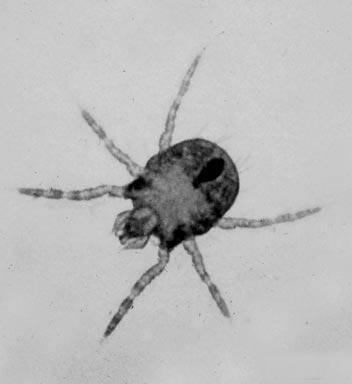About chiggers
-
Chiggers or red bugs are the tiny (1/120 - 1/150 inch) larvae of mites in the genus Eutrombicula.
-
Their bite causes intense itching and small reddish welts on the skin. Chiggers most frequently attach themselves at hair follicles in areas where clothing is tight-fitting such as the ankles, waist, and armpits. Contrary to popular belief, chiggers do not burrow into the skin or suck blood.
-
Chiggers feed on digested skin cells, not blood.
-
Itching is usually not felt for 3 to 6 hours after attachment and may persist for up to 2 weeks.
-
Scratching often removes the mite but can result in a secondary infection. Lathering and rinsing several times in a hot shower is the best way to remove any remaining chiggers. Prompt removal can lessen the duration and intensity of the itching.
-
Topical creams or ointments help to relieve itching. Ask your Physician for a recommendation.
-
Chiggers are not known to transmit any infectious diseases in the United States.
Life cycle
-
The life cycle of Chigger mites consists of several stages: egg, deutovum, larva, protonymph, deutonymph, tritonymph, and adult.
-
Only the larval stage bites humans.
-
Adults overwinter in the soil.
-
Eggs are laid in damp soil during the first warm spring weather.
-
After hatching, the larvae crawl on the soil or up grass blades in search of a host.
-
After attaching to the host, the larvae feed for up to 3 days.
-
The engorged larvae then drop to the soil to complete development to nymph, then adult.
-
The nymph and adult stages feed on arthropods.
Management
-
To reduce the incidence of chigger bites, use insect repellents and wear protective clothing when you are in chigger habitat. Long sleeved shirts and long pants, tied at the ankles, are recommended.
-
Chiggers are most often found in vegetation transition zones such as along the junction of forest and grass, along margins of swamps, brush thickets and even home lawns or golf courses.
-
Reduce chigger populations by keeping lawns mowed and shrubbery trimmed. These practices promote good air circulation, which dries out the area, making it less favorable for chigger development.
-
Use of pesticides to control chiggers is not recommended or effective.
